Hippies of Ibiza
Mrs. Müller Drops Out
Ibiza is known as a paradise for party animals. But the north of the Balearic Island is characterized by its untamed beauty and unspoiled nature. An Eden for dropouts.
Gitti Müller finds peace.
The Pyrenees stretch from the Atlantic to the Mediterranean, and are among the most beautiful mountain landscapes in Europe. Johanna Stöckl treks through the central stages of the mountains, through the provinces of Lleida and Huesca.
The heat is just bearable. One degree more – this is a threat to the universe – and I’m refusing to take another step. I’ll just lie down in the shadow of a tree and wait. Until sunset, if necessary! For the last few hours the sun has been beating down mercilessly on my head. My body is glowing from the inside out. I’m sweating from every pore. The thick socks in my heavy shoes are smoking. Still, I don’t let it show, of course. I keep going. Step by step. Up through the imposing gorge with its steep walls, in which six griffon vultures are having an enormous amount of fun in the heat. They’re using the thermals to sweep noiselessly through the warm air. One man’s joy is another man’s sorrow.
The good thing about walking in a group is the unspoken pressure it exerts. Too hot? Not in the mood? Not me! Why?
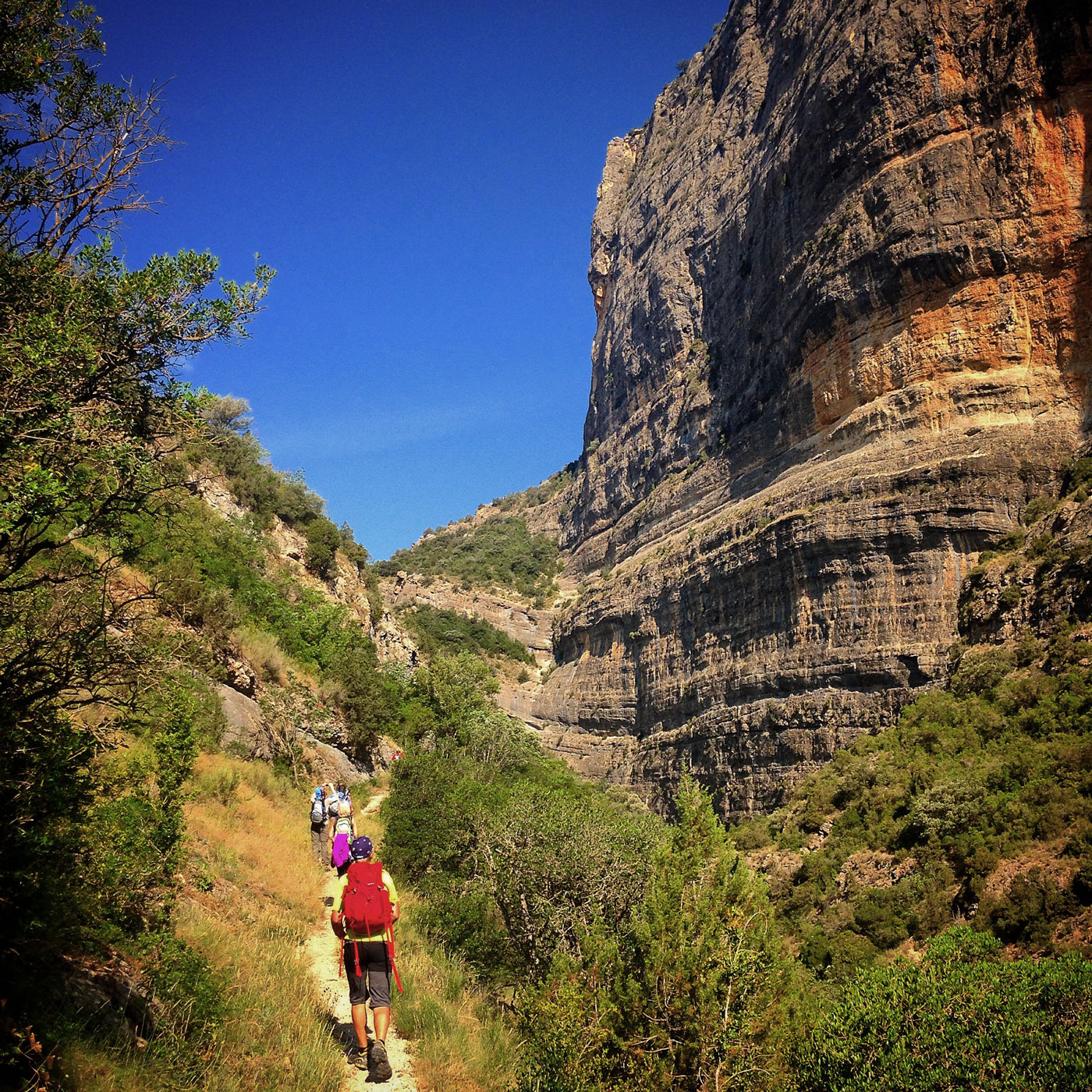
It’s both more awkward and more effective if, as is the case for me, you don’t really know your fellow walkers. None of my eight comrades wants to show any hint of weakness on the first day. Nobody wants to drop their guard.
So we keep climbing in single file.
Disciplined and silent, thanks to the heat. If I were with my boyfriend, he could discharge the tension in the atmosphere with a throwaway remark. Probably by channelling it into a fight. With a single ‚What’s wrong, not feeling fit today?‘ he’d tip me over the edge – I’m sure of it – into rage.
I’d curse and complain, stand still and blame him for everything, including the Spanish heat: we got up too late, we lingered too long over breakfast, etc. I’ve got to laugh. Despite my physical discomfort, I suddenly miss him intensely.
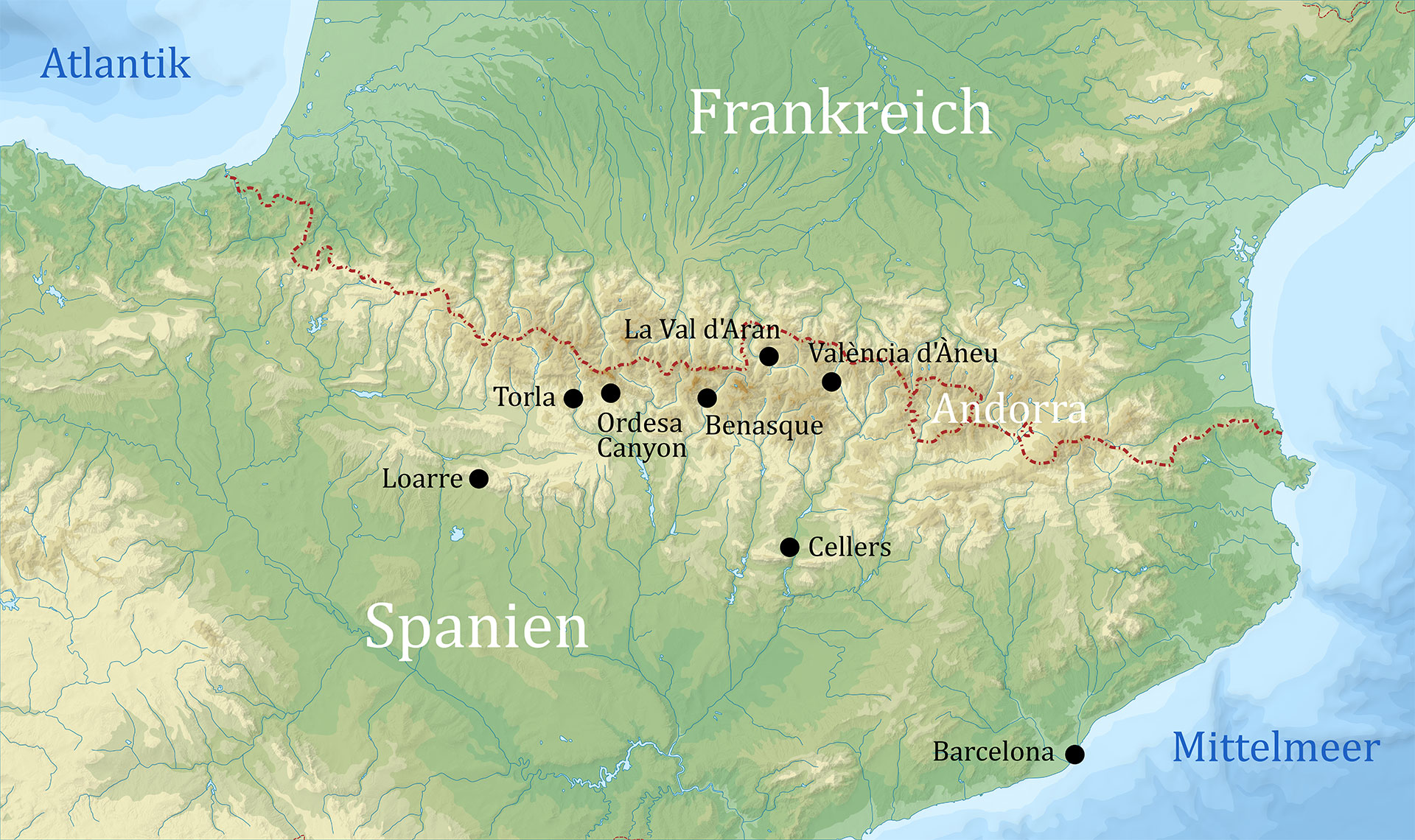
Still, I keep going, rashly determined to reach the highest point of the day’s walk as quickly as possible. The mere thought of my boyfriend at home spurs me on. How absurd: he’s not even here and I’m trying to prove something to him. My newly discovered mental technique for fighting heat-induced rage in the Pyrenees distracts me for at least half an hour. It works a miracle. Because at some point Harry finally stops. We’re given a break to have a drink, prescribed by the mountain guide himself.
I sling my rucksack from my shoulders, pull out my aluminium water bottle and drink. A lot. I eat an apple. Pausing to catch my breath, I enjoy the view of the Barranc del Bosc gorge behind us, which we’ve just crossed in a three-hour march from Terradets.
When Harry announces that it’s all downhill from now on, I’m overjoyed.
In fact, you couldn’t have a lovelier start to a walking holiday. The weather’s ideal, the group is nice, the landscape’s glorious. The thought of soon being able to leap into the nearby Pantà de Terradets lake or the hotel pool spurs us all on. As yet we’re not aware of the fact that in about two hours we’ll be standing in front of an ample buffet. It’s paradise: there will be artichokes with garlic oil, plenty of mussels, grilled lettuce hearts, cheese, olives, fresh tomatoes and delicious white wine.
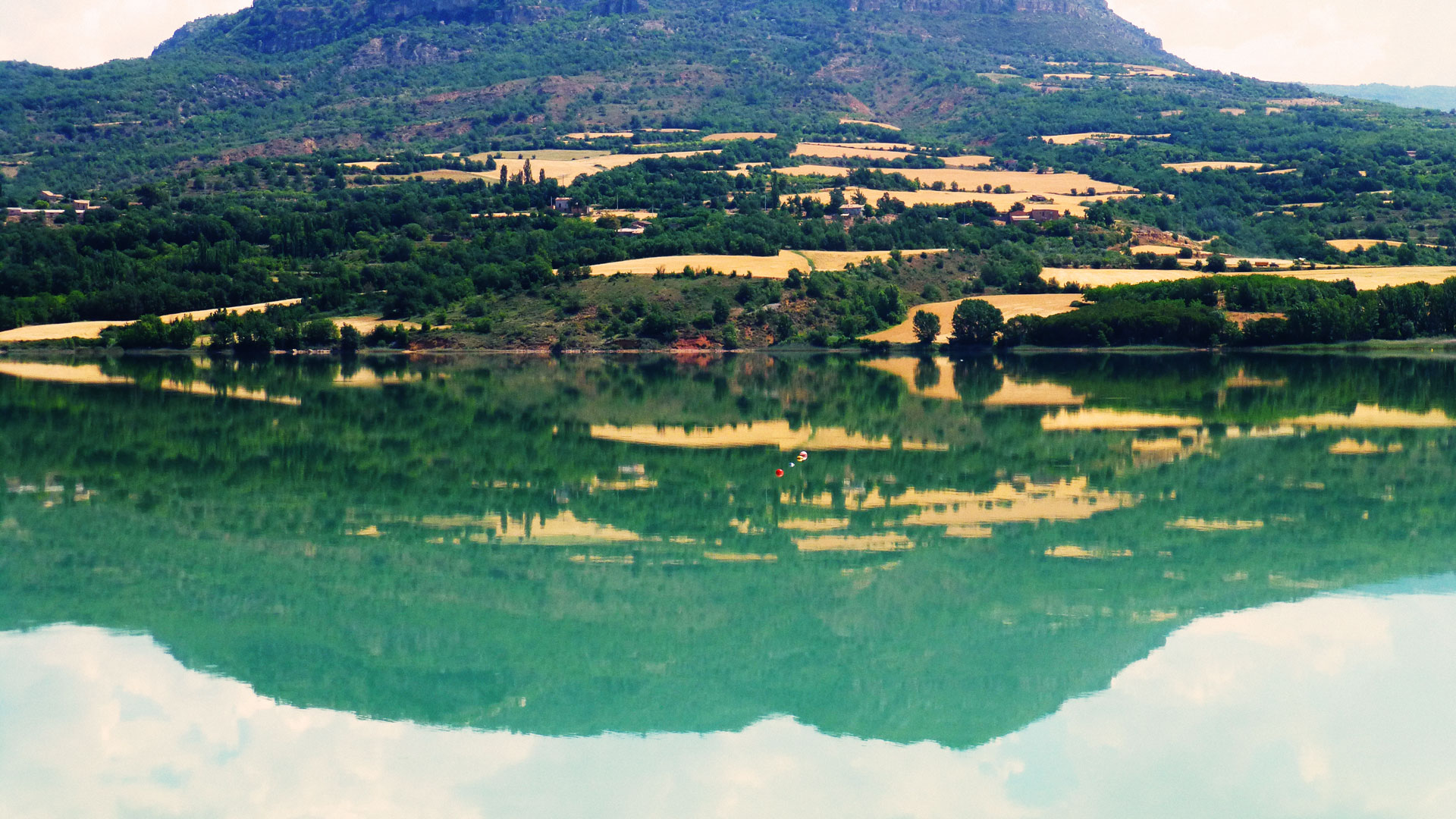
PS: My group consists of nine people in total. Other than the guide Harry Ebinger (who left Karlsruhe for Spain thirty years ago), we’re all German, and we all booked a guided walking holiday in the Spanish Pyrenees via the Summit Club, the German Alpine Society’s travel agency. We’re not sleeping in mountain huts, but in select accommodation that, while not luxurious, is – as it turns out – very charming. Each day we walk for between four and nine hours, and from day one we’ve got on pretty well. No stinkers in this group, unless you count our shoes.
* * *
The marvellous thing about a guided walking holiday is that you can focus entirely on the trek. I fall into a rhythm that revolves around walking, eating and sleeping.
Sounds boring? It isn’t.
Breaking the day down into stages gives you valuable time at each place you arrive, and you’re welcome to explore it independently if you feel like it. They also permit you – which is especially important during longer tours – to dedicate plenty of time to look after yourself and charge your batteries. People need time apart from the group, so you have time to yourself as well.
For me, as a coffee junkie, it’s crucial I can visit plenty of bars or small cafes where I can knock back at least an espresso or two. A brief conversation at the counter, plunging for at least a few minutes into the everyday lives of the locals, is probably what I’m most interested in.
In València d’Àneu, for instance, I take the time for a stroll with Achim through that magical place, which is inhabited by only a few hundred people. An uncanny silence reigns in the mountain village. Other than a few cats making themselves comfortable in the afternoon sun, we see no signs of life. On the stone houses, however, their roofs tiled with slate, colourful, flower-filled window boxes indicate that the homes are occupied. It’s a pretty village.
An ideal place to stay for a while, rent a room in one of the two nearby hotels and write a crime novel, I think to myself.
We follow the soft voices we can hear. There! A small bar. Outside the entrance are a few unoccupied tables and plastic chairs. We walk inside through a kitschy fringed curtain. The tiny shop is filled exclusively with elderly men in work clothes. Behind the counter stands a woman. It’s a shame our Spanish is so poor. We could have some interesting conversations here, I’m sure.
In a dark corner there’s a TV hanging on the wall. We see images of home. Angela Merkel and President Obama are at the G7 summit at Schloss Ellmau, which doesn’t seem to interest anybody here. And, to be honest, it doesn’t interest us either right now. We enjoy Achim’s small white wine and my large cortado outside. For thirty minutes nothing happens – absolutely nothing – on the street.

Then, as time stretches before us, a tractor comes chugging loudly around the corner. The gnarled old man steering it – cigarette in mouth, greasy cap on his head – waves at us in a friendly manner. Naturally we respond in kind. The simple greeting, nothing more than a fleeting gesture, is the high point of my afternoon.
Suddenly the wave makes me genuinely happy.
Long stretches of walking, however, really sap your strength. When you’re on your feet for eight hours a day at elevations of up to 1,000 metres, it changes your priorities. After arriving at the hotel all you want is to take a shower or a bath. Small luxuries can be truly blissful. The reason why I love to walk instead of driving is easily explained. When I walk I find myself totally at peace, while driving a car, for instance, stresses me out. When I walk I’m completely focused on the climb itself, and the corporeal is brought to the fore. Step by step. Up and down.
Because my job mainly involves sitting in front of a computer, being active outside is a longing of mine, an urge, really – certainly a wonderful way to spend free time. Hours of monotonous walking changes things in your head: you have time to play out curious thoughts, ideally reaching an almost meditative state. When I’m walking it’s not unusual for me to come up with fantastic ideas or solutions to problems in my everyday life.
Walking for long periods takes stamina, but on another level it releases loads of energy.
The scenery you’re travelling through can work wonders. Taking a moderate tempo gives you the opportunity to notice details in nature. In the Spanish Pyrenees, I walk through stretches of landscape so magnificent that I seriously consider returning to a particular place to spend more time there, or to experience the area in another season. Winter, for instance.
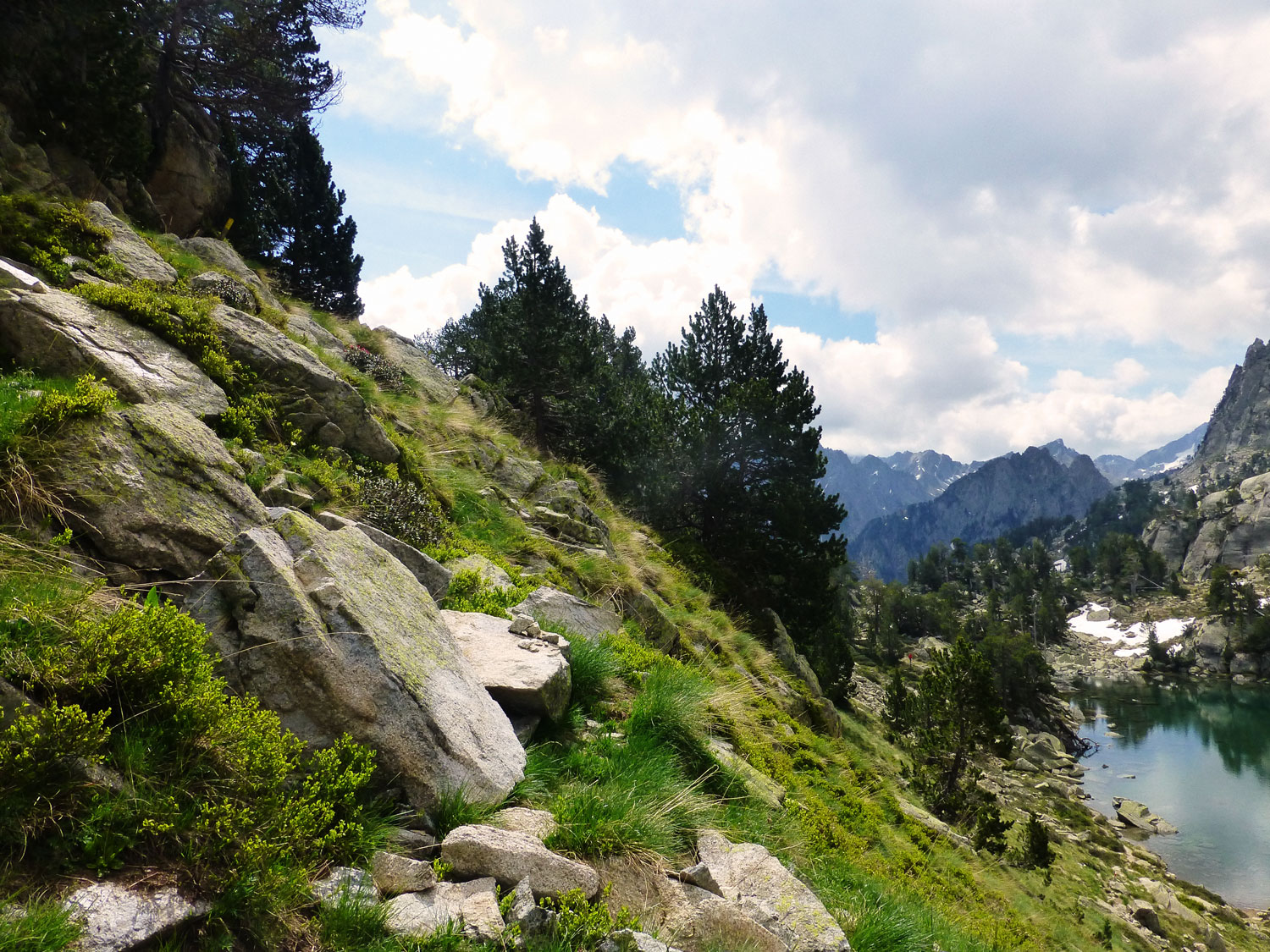
Food is, of course, never far from my mind, and on a walking holiday you can enjoy it guilt-free. After all, you use up far more calories than you can consume. From a culinary perspective, the Pyrenees have plenty to offer. Unlike in Spain’s chic cities or on the coast, in the mountains more hearty fare predominates. Apart from tapas and paella, we enjoy delicious lentil and chickpea stews, fresh salads every day, sausages of all kinds, lots of potatoes and soy cabbage, grilled black pudding and – as we’re not far from the French border – all sorts of homemade pâtés, served with baguettes before meals.
The fact that after a long period of walking we’re really longing for dinner has a positive effect on the atmosphere in the group. With every passing day the conversations at the dinner table get funnier, more relaxed and yet more intense. Our shared experience is gradually bringing us together, and as the days go by we become a well-oiled machine.
Every day we sleep somewhere new, and after a few days it means, oddly, that immediately after waking up I’m not sure exactly where I am. Sometimes I have to take a brief look out the window to reorientate myself. I printed out the schedule for the week with the descriptions of each stage and hotel, and it stays by my bedside every night.
Where was I today? Where are we going tomorrow?
* * *
The Pyrenees and birds – somehow they belong together. Curtain up! The stage is set for spectacular displays of flight against gigantic backdrops and an enchanting, early morning bird wedding.
As everybody knows, on a trekking holiday you carry your possessions in a rucksack on your back, and limit your choice of wardrobe to the bare (and ideally lightest) necessities. Paring back not only saves on weight but time. Without the agony of choice you never have to consider what to wear. And you don’t have to bother about taking ages to pack. If you’re meeting for breakfast at seven, for instance, you can confidently sleep in until 6.40. Twenty minutes is all you need to wash, brush your teeth, dress and pack your bag. You can shower in the evening. Every day we get better at shaving precious seconds off our time while still being punctual. Maximising sleep is everyone’s top priority. That’s the only way we can manage to reinvigorate our tired bodies day after day.
At 4.40 – a full two hours before the expected pinging of my mobile phone – I open my drowsy eyes because … well, because the alarm’s going off. Turn it off! Another five minutes …
… I drift off again.
The chirping doesn’t stop.
Ok. Slowly now. Turn on the light.
I’ve got to orientate myself: where am I, again? Oh yeah, Spain, the Pyrenees.
Panic: did I oversleep?
How late is it?
Perhaps I should add that, even in winter, I always sleep with my window open. Gradually I realise that the chirping isn’t coming from my phone. There’s a whole orchestra of birds twittering and peeping and chirping outside, just for me! I close my eyes again, deliberately, and enjoy listening to this free natural concert while I let my head sink back into the soft pillow. Louder voices come to the fore, while others, croakier, produce a kind of bass. And listen! There! Very tender, a magical warbling. Nothing can keep me in bed any longer.
Curtain up! The stage is set!
The Birds, live in concert!
I’ve got to get up, and I step out onto the balcony in my pyjamas to enjoy the Pyrenees Symphony. After all, sleeping in a concert hall is a faux pas.
Standing in the blue dawn, I literally fall out of time, tumbling headlong into a – how best to describe it? – almost a trance. While I’m being bewitched and lulled in equal measure by the various birds’ voice in the dead silence of the early morning, my gaze turns to the buildings opposite, which are lit by a single street lamp. In the early morning light, I can just make out the words ‚Hostal Cortina‘ on the desolate neon sign. I wonder about the history of this empty house in the middle of the Pyrenees, while a bat flits around my head. Why aren’t there any guests coming and going, as there are at the Hotel La Morera, where we’re staying? The old hotel would make a fabulous backdrop to an exciting thriller! A little murder, perhaps?

Back to my feathered friends. Birds and the Pyrenees – as I learn over the coming days – somehow belong together. For now, however, I’m anything but well-versed in ornithology, something I come to seriously regret after my musical experience on the balcony in València d’Àneu. I don’t know which voices belong to which birds. I’m able to recognise a blackbird, a swallow and a finch on sight, but when they’re hovering magnificently in the air I can’t really tell a golden eagle from a falcon. It’s a shame. I’d like to learn!
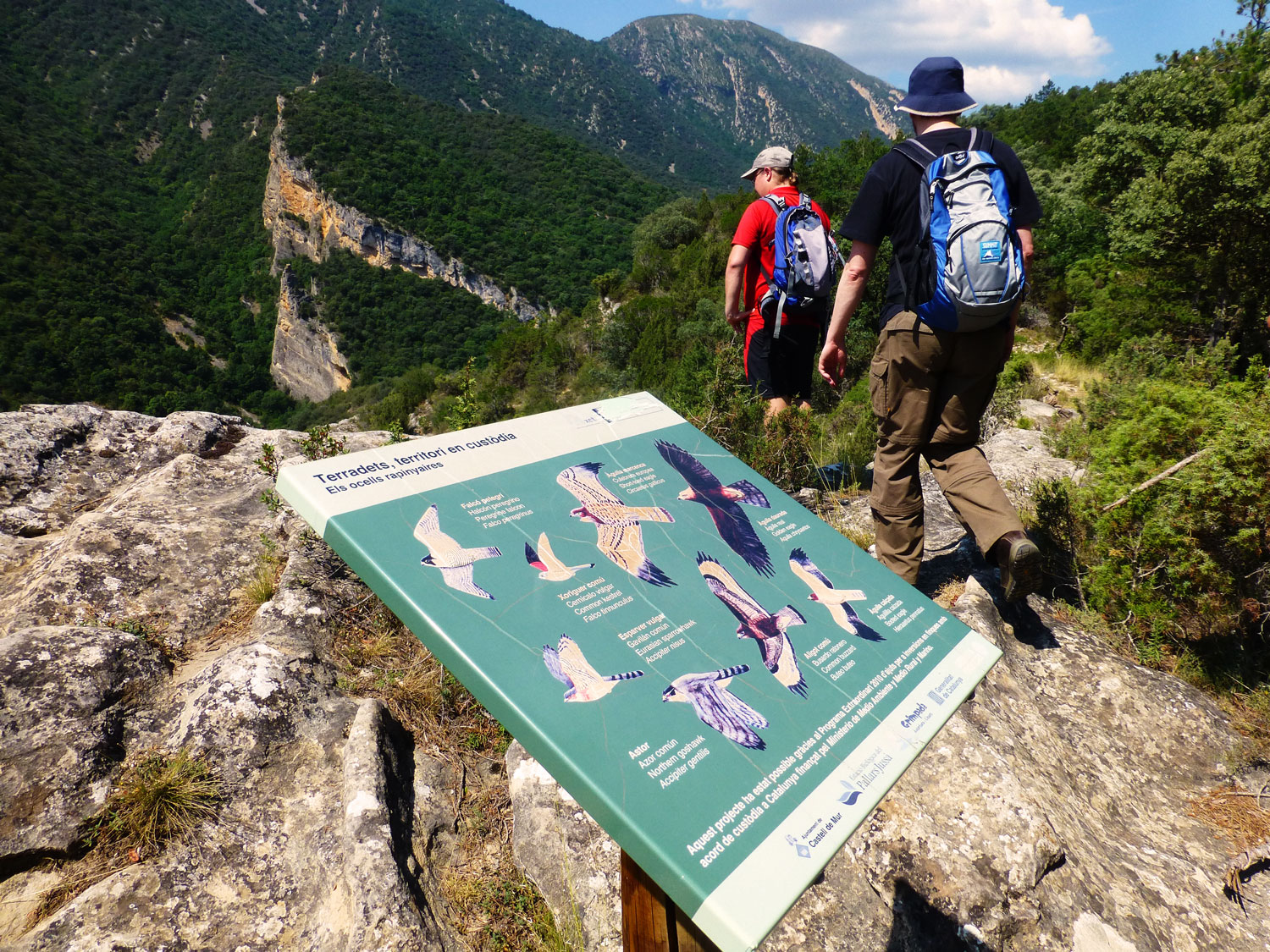
In the Pyrenees, birds are everywhere. The isolation of the mountains are an ideal environment for them to live and breed, so we’re treated to some spectacular displays of flight during our walks: imposing birds of prey like falcons, vultures and hawks are often circling the skies, and golden eagles, wood grouse and buzzards are native to the Pyrenees. But we also see significantly smaller birds suddenly come sailing by: ring ouzels, citril finches, wallcreepers and water pipits. Some of them, like the white-backed woodpecker, you hear but never see.
There are numerous agencies specialising in the bird-watching market, organising multi-day trips for twitchers from across the world. Claudia from Munich, whose hobby is ornithology, is a member of our walking group, and in Torla she suddenly flips out. Eating dinner at the Hotel Bujaruelo, she sees a man standing at the salad buffet whom she recognises from various specialist journals and publications: no question. It’s Roberto Cabo! If you’re trying to picture the situation, it’s as if I abruptly bumped into Lionel Messi in the dining room.
Roberto who? For us, the clueless ornithological newbies, Mr Cabo is just another hotel guest, albeit one who looks a bit like Richard Gere. But the German natural historian is a pretty big deal in the bird-watching scene, and his book A Guide to the Landscape of Spain is a kind of bible to anyone interested in Spain’s flora and fauna. Roberto is leading another German tour group. They’re exploring the Pyrenees on foot, focusing especially on botany, ornithology and natural history. Sightseeing for naturalists, in other words.
Insofar as the terrain permits, from now on I keep glancing up into the air as I walk …
* * *
Landscapes so breathtakingly beautiful that we can’t get enough of them. Scenery so intensely powerful that we want to stay there forever.
Many stages of the journey have a special quality even if they’re not particularly long. They’re somehow compelling, and we spend ages standing around, taking great photos, crazy selfies or amateur videos. Olaf, another member of the group, even takes out his notebook at regular intervals – totally analogue – to jot down notes and capture scenes in writing. Among the group he’s known as the ‚wandering poet‘.
In their own way, everyone in the group tries to capture the experience for all eternity, almost involuntarily.
From time to time, however, we fall silent, forgetting our cameras and Facebook pages, pausing, reflecting and enjoying the vistas opening up before us. It makes you want to grab a picnic basket, lay out a fluffy blanket and maybe a pillow, and dissolve into the scene, give yourself over to it, become absorbed into it.
Our first ‚wow‘ experience of this kind occurs in Aigüestortes National Park in Catalonia. More than 250 lakes huddle together at an elevation of between 1,700 and 2,700 metres, creating the largest concentration of high-alpine lakes in Europe. Who’d have thought! A lake district in the middle of the mountains! During our trip to the Refugi d’Amitges hotel, 2,380 metres above sea level, we can hear the water constantly chuckling and gurgling. We experience the sheer play of water: gently meandering streams, peaceful mountain lakes that reflect the peaks around them, marshy ponds, blossoming moors, thundering waterfalls and turbulent rivulets, swelled with snow, rushing down headlong into the valley.
At long last, at the end of the day, the heavens open and it pours with rain. As we leave the Hotel-Restaurant Roya in Espot, a delightful and more than 100-year-old hotel in a small village in the province of Lleida, it starts bucketing down, which means of course that we’re forced to get another cortado … and a nice pine liqueur.
In the north-east corner of Catalonia, in the heart of the Spanish Pyrenees, lies the Val d’Aran. To the north, the valley borders France. I was aware of the beauty of the region from numerous walking and skiing magazines, which, as we discover on our trip, has become more touristy than many other areas. In some ways it’s surprising, since for many years the mountain valley was rather isolated during the winter months. You simply couldn’t reach the valley from Spain, as you’d have to cross passes up to 2,450 metres high. In winter there was just one way to access it, from France. Only since they built a tunnel has the valley been accessible from both sides all year round.
Perhaps it’s precisely this long period of isolation that made the valley such a treasure?
The region harbours an internationally significant collection of Romanesque churches created in the eleventh and twelfth centuries by architects, artists and stonemasons from Lombardy.
On one tour we meet Elisa Ros, the custodian of the Val d’Aran’s cultural heritage, discovering that not only Spanish and Catalan but primarily Aranese is spoken in the valley. The language, which is not a dialect and is related to Occitan, has been used for many years. Of the 6,000 inhabitants of the valley, 65 percent still speak Aranese, a language otherwise only found in Southern France.

I’m dumbstruck by the Mont-Rebei gorge. This spectacular natural jewel was formed in the foothills of the Pyrenees by the Noguera Ribagorzana River, which wore through the Montsec Mountains over several million years, splitting the limestone cliffs. Anybody wandering, like us, through the eight-kilometre-long gorge, which involves passing over a suspension bridge, is also marching from Catalonia towards Aragón. At some places the gorge is so narrow that the 500-metre-high rock walls are nearly touching. Elsewhere the reddish canyon opens out, making space for the shimmering turquoise Canelles reservoir.
Nature is not the only one to create a masterpiece in this place.
Two Jacob’s ladders have been made by human hands.
Assuming you have a head for heights, you can climb the vertical walls. You don’t have to be a particularly good climber. Wooden steps, with thick cables as handrails, wind up the sheer rock face like a worm. What an experience!
Sometimes nature can be truly overpowering.
If you think rain could put a damper on our spirits or what we were able to do, you’re sorely mistaken. If you want to reach your goal with dry feet, the occasional rainfall ensures you have to move pretty quickly. On the Sendero de Cazadores, a hunting path in the Ordesa y Monte Perdido National Park, we stepped on the gas but eventually lost the race with Mother Nature. At the head of the valley, a plain surrounded by craggy mountain peaks, we’re greeted by a downpour that accompanies us into the valley.
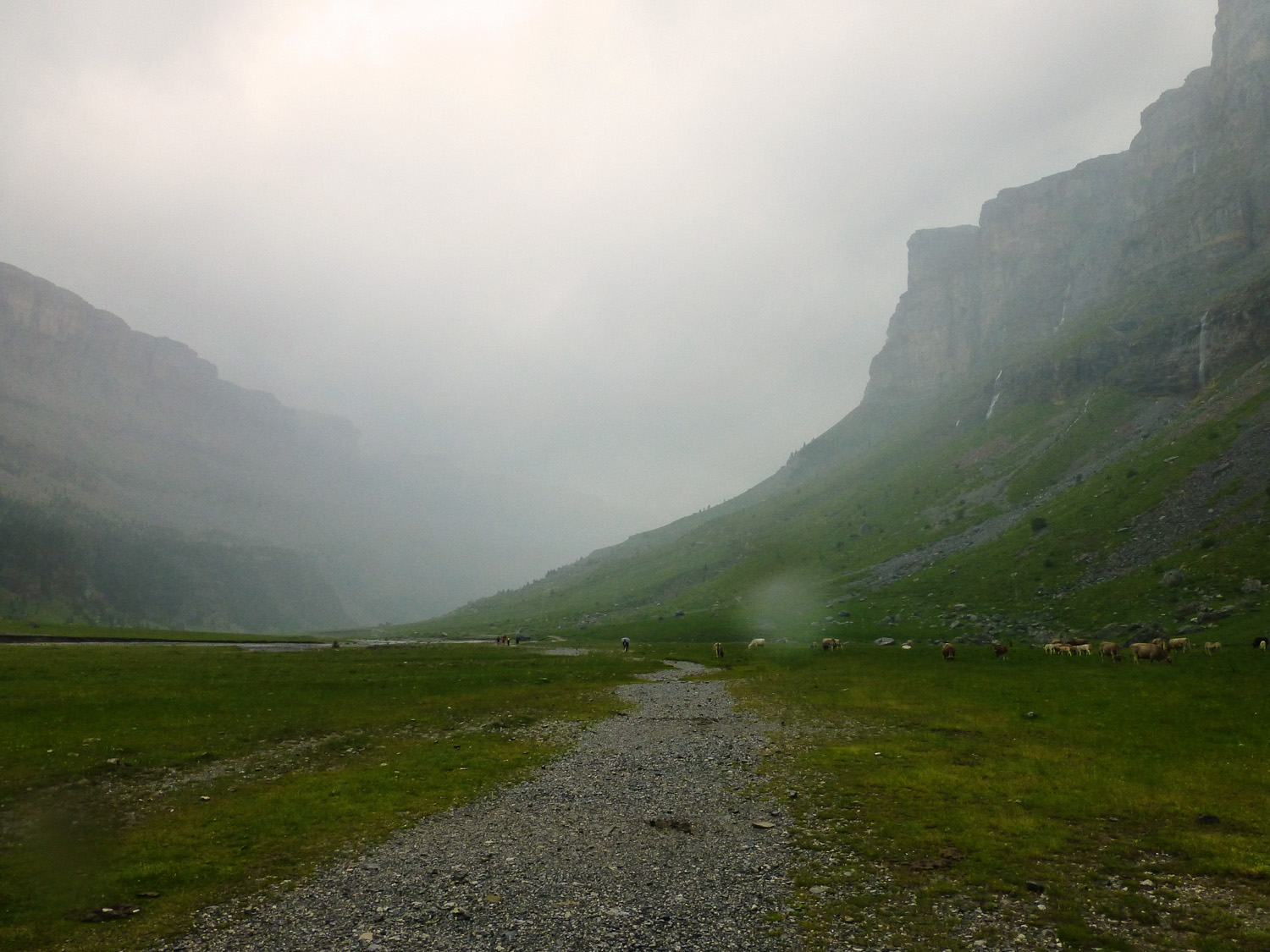
Dripping wet, we reach our accommodation for the following night, the Hospital de Benasque. While are shoes are drying in front of the hearth, we enjoy roast orange duck. Doesn’t sound much like losing, does it?
Heading home on a small bus taking us back to Barcelona, the Pyrenees open up before us once more, when we stop for a loo break at Riglos, a tiny village of 100 people – one final farewell highlight. At the steep conglomerate rock formations Mallos de Riglos, which rise as one out of nothing, climbing history has been made.

In the El Puro bar we indulge in a final nostalgic drink. On the wall hangs a signed photo of my idol. It was here that Alexander Huber free-climbed the Mallo Pisón, which now, seeing the protruding rock faces in reality, seems even more impressive. I’d love to walk around the towering rocks at least once, via the easy path.
It’s probably the diversity that I find so enduringly bewitching about the Pyrenees.
In terms of landscape, food, culture and even language, there’s a huge amount of contrast crammed into a relatively small area, so that it takes some time to orientate yourself in the overdose of sensory impressions, let alone to process them. Or you just take it a step further, travelling onwards. People who like the mountains will love the Pyrenees. On the GR 11, the lengthy footpath through the Spanish Pyrenees, I could theoretically walk from the Mediterranean all the way over the mountains to the Atlantic.
That would come to 800 kilometres and a 40,000-metre elevation gain. Maybe I should give it a shot?
* * *
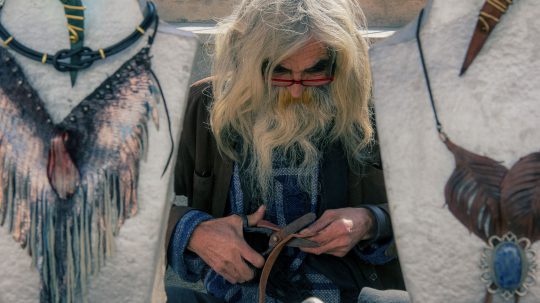
Ibiza is known as a paradise for party animals. But the north of the Balearic Island is characterized by its untamed beauty and unspoiled nature. An Eden for dropouts.
Gitti Müller finds peace.
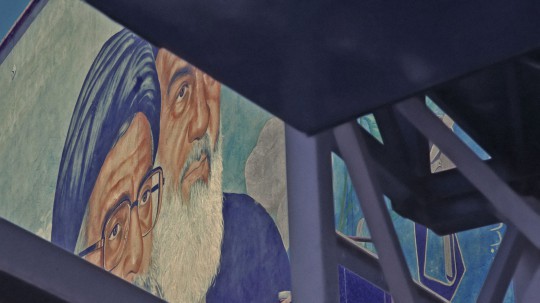
Officially, it’s prohibited. Still, Stefan Orth decides to couchsurf through Iran, thereby getting to know a country that doesn’t fit its image of a rogue state.
Ruanda Mister Guhonda und die letzten GorillasElfenbeinküste Die GeisterstadtUganda The Long Road to WaterKongo Crossing CongoSouth Africa: Kruger NP The Big FiveSomalia Welcome to Somalia
USA: Florida 100 miles on the tracks of the CalusaUSA Arm, aber frei – als Hobo durch AmerikaBrasilien Rio de JaneiroArgentinien Aconcagua, 6962 MeterPeru Zwischen Himmel und ErdeUSA: Utah WestworldKuba Drüben, in der anderen WeltKaribik TraumschiffMexiko Comeback mit Backpack in MexikoUSA: Alaska Big RiverNicaragua The Magic of the Corn IslandsUSA: Alaska Alone in the WildernessUSA: Colorado Rocky Mountain High
Antarctic Happy Antarctica
Iran Hochzeit im IranChina Urlaub im ÜberwachungsstaatKatar Fata Morgana Allgäu Orient RallyeMongolei Gekritzel im Sand gegen die große EinsamkeitSyrien Willkommen in SyrienUsbekistan Ein Meer aus SandIndonesien Meine Tage als BuleJordanien JungeBurma Nachtzug nach BaganKirgisistan Die Flügel des MenschenBurma Goldene ZeitenRussland Couchsurfing in RussiaThailand Der Pfad der ErleuchtungAfghanistan KabulChina K2Pakistan Hitchhiking Through Pakistan On the Road of LifePhilippinen Me, Love and Other CatastrophesIran Kids of TehranBangladesh Life and Death in the Empire of the TigerIran Couchsurfing in IranBurma Road to MandalayVietnam Lost in Vietnam
Spanien Ungezähmte BergeFrankreich Yoga und SurfenGermany Ein Esel zum PferdestehlenAustria Der Geschmack des WaldesGermany Vier Räder, Küche, BadFinnland Sehnsucht nach SchneeGermany Mehr Pott geht nichtAustria Mach mal langsamFinnland Hoch in den NordenRumänien In RuinenGermany Grenzgänge durch BrandenburgGermany Towards WinterGermany Das blaue ParadiesSchweiz Zur grünen StundeNorwegen The Rest is Silence Germany ZauberlandSpanien Mrs. Müller Drops OutNorwegen Ultimate FreedomSpanien Into the Heart of the PyreneesFinnland Wandering CosmosGermany The Bundesliga village Germany Under The DomePoland Warszawa rzucająca na kolana On the Road of LifeGermany Munich: Oh well, I live here. So?Germany Jena: Next Stop ParadiseGermany Bochum: Steel HeartbeatsTürkei Arrival in Istanbul Italy Dear Dolomites, I'm BackTürkei Floodlights in the ForestCroatia Ambuscade at the BorderGermany The Bavarian OlympicsAustria Across (Goat) CountryLatvia Somewhere up thereGermany The Big GoalGermany My Loveletter to LangeoogGermany The End of a Journey
Auf der Rückseite des GlobusNew Zealand Speed Dating with New Zealand
Welt Six Pairs of Shoes
Germany Ein Esel zum PferdestehlenGermany Vier Räder, Küche, Bad Freiheit auf vier RädernChina Urlaub im ÜberwachungsstaatUSA Arm, aber frei – als Hobo durch AmerikaKuba Drüben, in der anderen Welt Auf der Rückseite des GlobusFinnland Hoch in den NordenSyrien Willkommen in SyrienUsbekistan Ein Meer aus SandElfenbeinküste Die GeisterstadtBurma Goldene ZeitenRussland Couchsurfing in RussiaGermany Das blaue ParadiesSchweiz Zur grünen StundeNicaragua The Magic of the Corn IslandsKongo Crossing CongoNorwegen Ultimate FreedomSpanien Into the Heart of the Pyrenees On the Road of LifePhilippinen Me, Love and Other CatastrophesTürkei Arrival in Istanbul Türkei Floodlights in the ForestCroatia Ambuscade at the BorderAustria Across (Goat) CountryGermany The Big GoalNew Zealand Speed Dating with New ZealandAntarctic Happy AntarcticaBurma Road to MandalayVietnam Lost in Vietnam
Spanien Ungezähmte BergeGrönland Gefangen im EisIran Hochzeit im IranUSA: Florida 100 miles on the tracks of the CalusaBrasilien Rio de JaneiroArgentinien Aconcagua, 6962 MeterPeru Zwischen Himmel und ErdeUSA: Utah Westworld Allgäu Orient RallyeFinnland Sehnsucht nach SchneeRuanda Mister Guhonda und die letzten GorillasMongolei Gekritzel im Sand gegen die große EinsamkeitRumänien In RuinenJordanien JungeUSA: Alaska Big RiverUganda The Long Road to WaterAfghanistan KabulNorwegen The Rest is Silence Germany Under The DomeChina K2USA: Alaska Alone in the WildernessPakistan Hitchhiking Through PakistanIran Kids of TehranUSA: Colorado Rocky Mountain HighBangladesh Life and Death in the Empire of the TigerIran Couchsurfing in IranSomalia Welcome to Somalia
Frankreich Yoga und SurfenAustria Der Geschmack des WaldesKatar Fata MorganaKaribik TraumschiffGermany Mehr Pott geht nichtAustria Mach mal langsamIndonesien Meine Tage als BuleGermany Grenzgänge durch BrandenburgBurma Nachtzug nach BaganKirgisistan Die Flügel des MenschenMexiko Comeback mit Backpack in MexikoGermany Towards WinterThailand Der Pfad der ErleuchtungWelt Six Pairs of ShoesGermany ZauberlandSpanien Mrs. Müller Drops OutFinnland Wandering CosmosGermany The Bundesliga village Poland Warszawa rzucająca na kolanaGermany Munich: Oh well, I live here. So?Germany Jena: Next Stop ParadiseGermany Bochum: Steel HeartbeatsItaly Dear Dolomites, I'm BackGermany The Bavarian OlympicsLatvia Somewhere up thereSouth Africa: Kruger NP The Big FiveGermany My Loveletter to LangeoogGermany The End of a Journey
Readers Mail
Tell us what you think
Birgitta & Alex on 1. Mai 2016
Liebe Johanna,
man spürt, mit welcher Leidenschaft du über deine persönlichen Erfahrungen berichtest. Du solltest das hauptberuflich mit deinem eigenen Blog machen. :-)
Saludos desde München
Birgitta & Alejandro
Johanna Stöckl on 3. Mai 2016
Liebe Brigitta,
lieber Alejandro,
danke für euer nettes Feedback. Ja ich schreibe gerne, vor allem, wenn ich mich nicht einschränken oder an strenge Vorgaben halten muss. Ich lebe vom Schreiben und beliefere Tageszeitungen und Magazine. Einen eigenen Blog? Daran habe ich irgendwie noch nie gedacht ;-) Mir reicht es, wenn ich ab und an was für die Travel Episodes liefern darf. Lieben Gruß nach Spanien! Johanna
Christian Kuhn on 16. Mai 2016
Unglaublich toller Bericht. Ich liebe den Norden Spanien und vor allem die Pyrenäen. Eine Freundin von mir wohnt dort auf einem Einsiedlerhof und ich war völlig begeistert von der dortigen Natur. Danke für die tollen Bilder und den sehr schön geschriebenen Bericht!
Johanna Stöckl on 20. Mai 2016
Lieber Christian,
da du die Pyrenäen kennst, freue ich mich ganz besonders über dein Feedback hier. Das mit der Freundin und dem Einsiedlerhof klingt spannend. Wo genau lebt die Dame denn? Dir wünsche ich eine gute Zeit und dass du hoffentlich bald wieder in die Pyrenäen aufbrechen kannst.
Lieben Gruß vom Schreibtisch in München von der
Johanna :-)